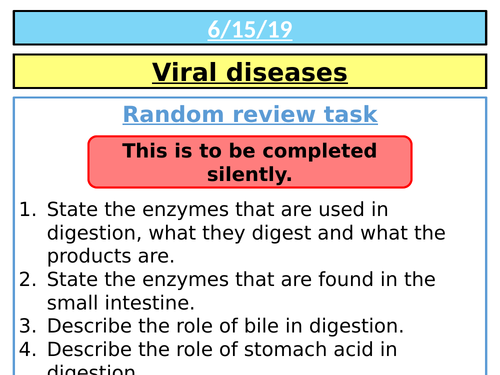
42Uploads
7k+Views
1k+Downloads
All resources

AQA GCSE (9-1) - Power and efficiency
The lesson covers power and efficiency and has differentiated questions within the powerpoint. The higher level questions are on a hidden slide that can be printed out. The efficiency worksheet has a variety of questions for all levels.

AQA GCSE (9-1) Biology - Viral diseases
The lesson is in line with B5.6 (Kerboodle scheme of work).
This lesson covers how viruses infect and cause damage to organisms; information regarding measles, HIV and tobacco mosaic virus(information sheet attached. Depending on group ability there is a whiteboard quiz, level 1-4 question sheet, level 5-9 question sheet.

AQA GCSE (9-1) Biology (Triple) - The eye
All full lesson covering half of the content needed for the AQA specification component 4.5.2.3. Problems with the eye is the other lesson linked to this one.

Laboratory equipment & Bunsen burner safety
Second lesson in the enquiry processes and safety lessons series. This lesson focuses on the different laboratory equipment students will need to be confident using in order to carry out practical investigations.
Also contains how to use a Bunsen burner with a Bunsen burner license template.

AQA GCSE (9-1) Biology (Triple) - The brain
A full lesson on the brain covering all the content in the AQA specification for component 4.5.2.2.

AQA GCSE (9-1) Biology (Triple) - Problems with the eye
All full lesson covering half of the content needed for the AQA specification component 4.5.2.3. The eye is the other lesson linked to this one.

Critiquing evidence and sources
Seventh lesson in a the enquiry processes and safety lessons series. This lesson focuses on how to critique evidence and sources related to scientific literature allowing pupils to assess the reliability of a resource.

KS3 - Static electricity
Fully resourced lesson covering static electricity for KS3 pupils (years 7-8, but can be used for year 9).

AQA GCSE (9-1) Biology (Triple) - Culturing microorganisms
The lesson is in line with B5.4 (Kerboodle scheme of work).
This lesson outlines the needs that bacteria have with regards to growing effectively; RPA 2: investigate the effect of antiseptics or antibiotics on bacterial growth using agar plates and measuring zones of inhibition; calculating zones of inhibition.

AQA GCSE (9-1) - Magnetic fields
This lesson covers specification number: 6.7.1.2 of the AQA Combined Trilogy course.

Planning investigations
Third lesson in a series of lessons on enquiry processes and safety. This lesson focuses on how to plan investigations and carry them out safely.
This lesson uses an A3 sheet that students can use to while they complete the lesson.

Laboratory safety
First lesson in a series of lessons to cover enquiry processes and safety in science. This first lesson covers basic laboratory safety and can be used as a first lesson for year 7 or year 8 as a reminder.

Evaluating data
Sixth lesson in a series of lessons on enquiry processes and safety. This lesson focuses on how to evaluate data.
This lesson uses an A3 sheet that students can use to while they complete the lesson.

AQA GCSE (9-1) Physics - Wave calculations
A fully resourced lesson covering wave speed and wave period calculations.

AQA GCSE (9-1) Physics - Vectors & scalars, contact & non-contact forces
Fully resourced lesson that covers the basics of forces for the first lesson in the forces topic for GCSE Physics (AQA).

KS3 - Series and parallel circuits
A fully resourced lesson covering series and parallel circuits for KS3, but can also be used for GCSE.

KS3 - Magnets and magnetic fields
A fully resourced lesson covering magnets and magnetic fields for KS3 pupils (years 7-8) but can also be used to introduce magnetism for KS4 pupils.

AQA GCSE (9-1) - Energy stores
The lesson is all provided on the powerpoint slides. A sheet for less able pupils can be made easily for pupils to add in information.

AQA GCSE (9-1) - Specific heat capacity
Lessons covering specific heat capacity, there is a video and questions covering the success criteria.

AQA GCSE (9-1) - Resistance & calculating resistance
Lesson aimed at a middle attaining year 9 group, but can be differentiated up and down. There is a slide for pupils to fill in the information while the listen and watch the anology of resistance through a video (linked for copyrighting issues) and slideshow.




















